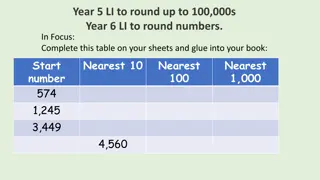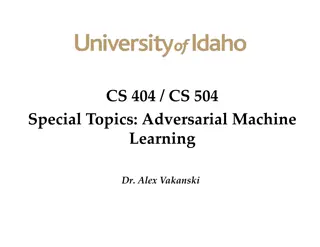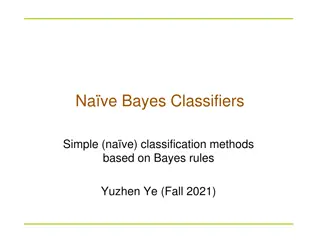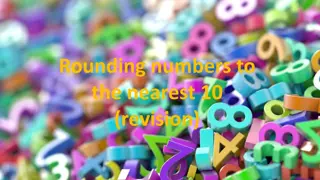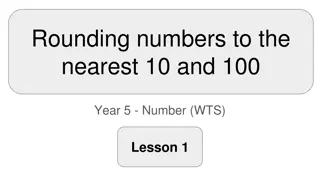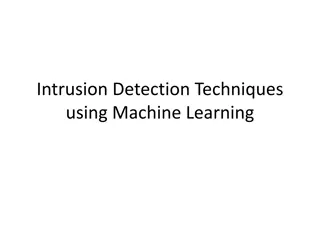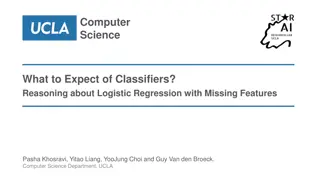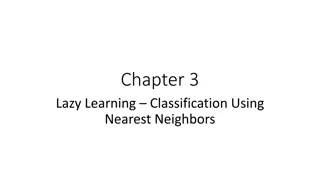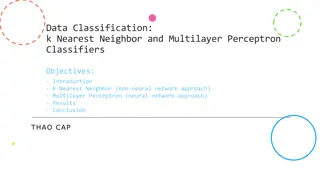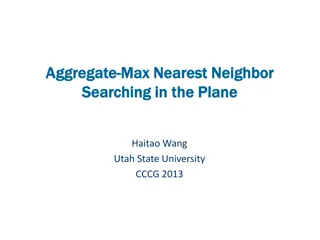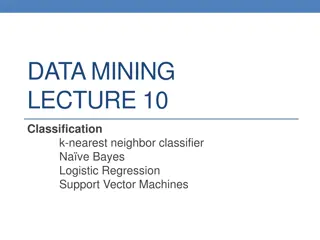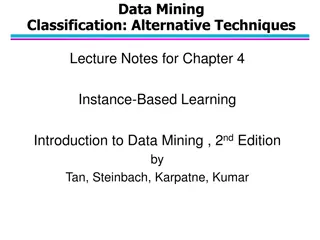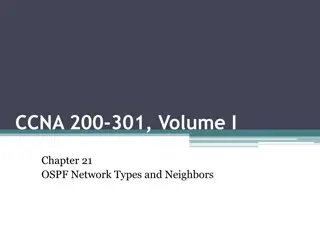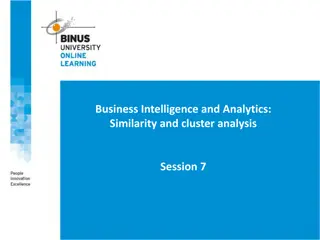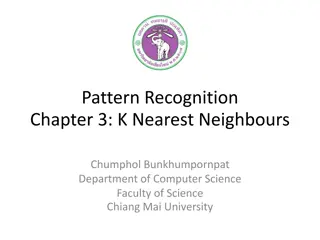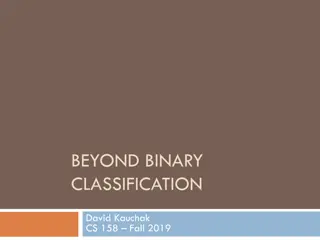Understanding Nearest Neighbor Classifiers in Machine Learning
Nearest Neighbor Classifiers are a fundamental concept in machine learning, including k-Nearest Neighbor (k-NN) Classification. This method involves assigning a test sample the majority category label of its k nearest training samples. The rule is to find the k-nearest neighbors of a record based on the smallest distance to that record. Voronoi Diagrams, distance-weighted k-NN, and predicting continuous values using k are also discussed. Explore these concepts to enhance your understanding of this classification technique.
Download Presentation

Please find below an Image/Link to download the presentation.
The content on the website is provided AS IS for your information and personal use only. It may not be sold, licensed, or shared on other websites without obtaining consent from the author. Download presentation by click this link. If you encounter any issues during the download, it is possible that the publisher has removed the file from their server.
E N D
Presentation Transcript
Bayes Classifier: Recap P( TUNA | L) P( SHARK | L) P( HILSA | L) L Maximum Aposteriori (MAP) Rule Distributions assumed to be of particular family (e.g., Gaussian), and parameters estimated from training data.
Bayes Classifier: Recap P( TUNA | L) P( SHARK | L) P( HILSA | L) L +- Approximate Maximum Aposteriori (MAP) Rule Non-parametric (data driven) approach: consider a small window around L, Find which class is most populous in that window.
Nearest Neighbor Classifiers Basic idea: If it walks like a duck, quacks like a duck, then it s probably a duck Compute Distance Test Record Training Records Choose k of the nearest records
Basic Idea k-NN classification rule is to assign to a test sample the majority category label of its k nearest training samples In practice, k is usually chosen to be odd, so as to avoid ties The k = 1 rule is generally called the nearest-neighbor classification rule
Definition of Nearest Neighbor X X X (a) 1-nearest neighbor (b) 2-nearest neighbor (c) 3-nearest neighbor K-nearest neighbors of a record x are data points that have the k smallest distance to x
Voronoi Diagram Properties: 1) All possible points within a sample's Voronoi cell are the nearest neighboring points for that sample 2) For any sample, the nearest sample is determined by the closest Voronoi cell edge
Distance-weighted k-NN k Replace by: = i f ( = d ) arg max ( , ( )) q v f x i v V 1 k 1 f (q) =argmax 2d(v, f (xi)) d xi,xq ( ) v V i=1 General Kernel functions like Parzen Windows may be considered Instead of inverse distance.
Predicting Continuous Values k Replace by: f v , = i f ( = d ) arg max ( ( )) q w x i i v V 1 k = i Note: unweighted corresponds to wi=1 for all i ( ) w f x i i f ( 1 = ) q k = i w i 1
Nearest-Neighbor Classifiers: Issues The value of k, the number of nearest neighbors to retrieve Choice of Distance Metric to compute distance between records Computational complexity Size of training set Dimension of data
Value of K Choosing the value of k: If k is too small, sensitive to noise points If k is too large, neighborhood may include points from other classes Rule of thumb: K = sqrt(N) N: number of training points X
Distance Measure: Scale Effects Different features may have different measurement scales E.g., patient weight in kg (range [50,200]) vs. blood protein values in ng/dL (range [-3,3]) Consequences Patient weight will have a much greater influence on the distance between samples May bias the performance of the classifier
Standardization Transform raw feature values into z-scores zij=xij-mj zij=xij-mj sj sj is the value for the ith sample and jth feature is the average of all for feature j is the standard deviation of all over all input samples Range and scale of z-scores should be similar (providing distributions of raw feature values are alike) xij mj sj xij xij
Nearest Neighbor : Dimensionality Problem with Euclidean measure: High dimensional data curse of dimensionality Can produce counter-intuitive results Shrinking density sparsification effect 1 1 1 1 1 1 1 1 1 1 1 0 1 0 0 0 0 0 0 0 0 0 0 0 vs 0 1 1 1 1 1 1 1 1 1 1 1 0 0 0 0 0 0 0 0 0 0 0 1 d = 1.4142 d = 1.4142
Distance for Heterogeneous Data Wilson, D. R. and Martinez, T. R., Improved Heterogeneous Distance Functions, Journal of Artificial Intelligence Research, vol. 6, no. 1, pp. 1-34, 1997
Nearest Neighbour : Computational Complexity Expensive To determine the nearest neighbour of a query point q, must compute the distance to all N training examples + Pre-sort training examples into fast data structures (kd-trees) + Compute only an approximate distance (LSH) + Remove redundant data (condensing) Storage Requirements Must store all training data P + Remove redundant data (condensing) - Pre-sorting often increases the storage requirements High Dimensional Data Curse of Dimensionality Required amount of training data increases exponentially with dimension Computational cost also increases dramatically Partitioning techniques degrade to linear search in high dimension
Reduction in Computational Complexity Reduce size of training set Condensation, editing Use geometric data structure for high dimensional search
Condensation: Decision Regions Each cell contains one sample, and every location within the cell is closer to that sample than to any other sample. A Voronoi diagram divides the space into such cells. Every query point will be assigned the classification of the sample within that cell. The decision boundary separates the class regions based on the 1-NN decision rule. Knowledge of this boundary is sufficient to classify new points. The boundary itself is rarely computed; many algorithms seek to retain only those points necessary to generate an identical boundary.
Condensing Aim is to reduce the number of training samples Retain only the samples that are needed to define the decision boundary Decision Boundary Consistent a subset whose nearest neighbour decision boundary is identical to the boundary of the entire training set Minimum Consistent Set the smallest subset of the training data that correctly classifies all of the original training data Original data Condensed data Minimum Consistent Set
Condensing Condensed Nearest Neighbour (CNN) Incremental Order dependent Neither minimal nor decision boundary consistent O(n3) for brute-force method 1. Initialize subset with a single (or K) training example Classify all remaining samples using the subset, and transfer any incorrectly classified samples to the subset Return to 2 until no transfers occurred or the subset is full 2. 3.
Condensing Condensed Nearest Neighbour (CNN) 1. Initialize subset with a single training example Classify all remaining samples using the subset, and transfer any incorrectly classified samples to the subset Return to 2 until no transfers occurred or the subset is full 2. 3.
Condensing Condensed Nearest Neighbour (CNN) 1. Initialize subset with a single training example Classify all remaining samples using the subset, and transfer any incorrectly classified samples to the subset Return to 2 until no transfers occurred or the subset is full 2. 3.
Condensing Condensed Nearest Neighbour (CNN) 1. Initialize subset with a single training example Classify all remaining samples using the subset, and transfer any incorrectly classified samples to the subset Return to 2 until no transfers occurred or the subset is full 2. 3.
Condensing Condensed Nearest Neighbour (CNN) 1. Initialize subset with a single training example Classify all remaining samples using the subset, and transfer any incorrectly classified samples to the subset Return to 2 until no transfers occurred or the subset is full 2. 3.
Condensing Condensed Nearest Neighbour (CNN) 1. Initialize subset with a single training example Classify all remaining samples using the subset, and transfer any incorrectly classified samples to the subset Return to 2 until no transfers occurred or the subset is full 2. 3.
Condensing Condensed Nearest Neighbour (CNN) 1. Initialize subset with a single training example Classify all remaining samples using the subset, and transfer any incorrectly classified samples to the subset Return to 2 until no transfers occurred or the subset is full 2. 3.
High dimensional search Given a point set and a nearest neighbor query point Find the points enclosed in a rectangle (range) around the query Perform linear search for nearest neighbor only in the rectangle Query
kd-tree: data structure for range search Index data into a tree Search on the tree Tree construction: At each level we use a different dimension to split x=5 x>=5 x<5 C y=6 B y=3 E x=6 A D
kd-tree example X=7 X=5 X=3 y=6 y=5 Y=6 x=8 x=7 x=3 y=2 Y=2 X=5 X=8
KNN: Alternate Terminologies Instance Based Learning Lazy Learning Case Based Reasoning Exemplar Based Learning


